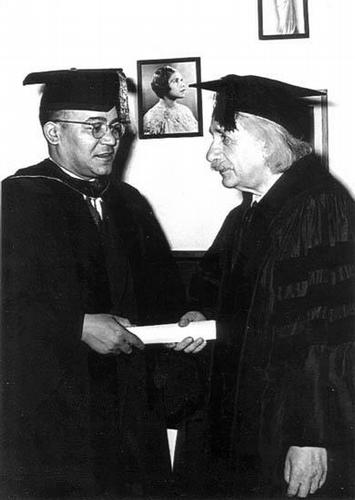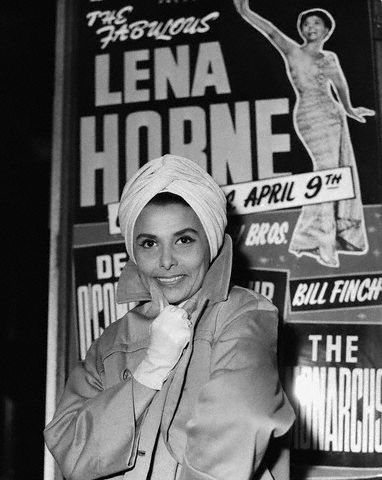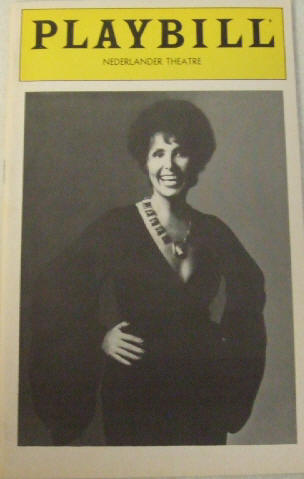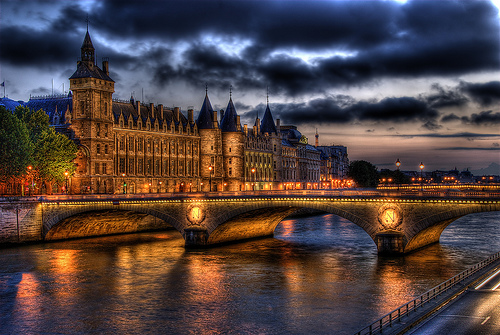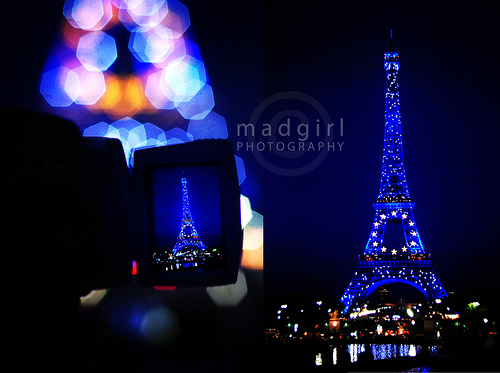Marian Anderson and Albert Einstein were friends!! Like, friends. Not acquaintances. I am related to Marian Anderson and she hung out with Einstein. Considering the purposefully reposted quote along side Einstein’s notion that the limiters of potential are limited as well, I imagine they had some profound conversations. That’s nearly as impressive to me as her “dissing” the D.A.R. by singing on the steps outside in response to their choice to disrespect her in honor of the organization’s racial exclusion policy.
Anyway, here’s more on Einstein’s stand for equality. It was a lot more involved than delivering a speech at a University, and there are many more details here than in the article posted yesterday. Not that the speech wasn’t as big of a deal as I thought. It was! Not only was Mr. Einstein brave enough to speak out, he did it while he was ill. Outside. Ok, it was May, so maybe the weather was fine, but I’m just saying if he was looking for an excuse not to speak, sounds like he had it, but chose not to use it. Instead, he got up there and spoke to the impressionable minds of the “first institution found anywhere in the world to provide a higher education in the arts and sciences for male youth of African descent.” If young African American males today are largely still in need of academic encouragement and inspiration and respect, I can only imagine how impactful and empowering Einstein’s presence alone was pre Brown vs. Board of Ed. Just the simple fact that he spoke, and the forbidden, unspoken truth contained in his words. I have a feeling this brilliant man knew exactly what he was doing.
Albert Einstein, I acknowledge your greatness as a champion of human and civil rights and your hand in illuminating the fact that limiting the potential of a significant portion of society limits everyone in that society.
Thank you.
xo,
Tiff
Albert Einstein at Lincoln University
(photo of Marian Anderson in background?)
Albert Einstein passionately fought race prejudice, according to new and old docs
by Ronda Racha Penrice
Nearly 60 years after his death, the great scientist Albert Einstein is still making headlines. The launch of Einstein Archives Online — a more advanced repository of his work — is a long-term collaboration by Israel’s Hebrew University, which he co-founded, California Institute of Technology (Caltech), where he was a guest faculty member on several occasions, and Princeton University, where he was a faculty member, generated global attention on March 19. Eventually, over 80,000 documents held in Hebrew University’s Albert Einstein Archives and Caltech’s Einstein Papers Project will be available on the Internet. About 2,000 are currently available.
Despite this unprecedented access, however, one thing hasn’t changed: Einstein’s strong support of African-American civil rights and his defiant stance against racism are largely footnotes, especially for the mainstream press. While it will, no doubt, be exciting to pull up correspondence between Einstein and W.E.B. Du Bois one day, his association with Du Bois was just the tip of the iceberg.
Einstein, as documented in the 2003 book Einstein on Race and Racism by veteran science writer and journalist Fred Jerome, who also covered civil rights activity in the South in the 1960s, and New York librarian Rodger Taylor whose early writings have focused on jazz and early African-American life in New York, staunchly denounced racism and segregation in the United States, even as his health steadily failed and his own mortality drew nearer.
Jerome first delved into Einstein’s human rights advocacy in his 2002 book, The Einstein File: J. Edgar Hoover’s Secret War Against the World’s Most Famous Scientist. In that groundbreaking work, Jerome highlighted a May 3, 1946 speech Einstein gave at historic Lincoln University, the alma mater of both Thurgood Marshall and Langston Hughes and, as its then president Horace Mann Bond pointed out, “the first institution found anywhere in the world to provide a higher education in the arts and sciences for male youth of African descent.” Interestingly, a young Julian Bond, Horace Mann Bond’s son, was there that day.
The speech was especially significant because, as Jerome also writes in The Einstein File, “During the last twenty years of his life, Einstein almost never spoke at universities.” He routinely turned down almost all of the honorary degree requests he received.
On top of that, Einstein’s health was not the greatest. Yet, he stood outdoors to receive his honorary degree from Lincoln University, which can actually be viewed on the Einstein Archives Online now, and, even more importantly, spoke these poignant words reported in the Baltimore Afro-American May 11, 1946: “There is separation of colored people from white people in the United States. That separation is not a disease of colored people. It is a disease of white people. I do not intend to be quiet about it.”
And he was not. Einstein, as Jerome notes in his essay The Hidden Half-Life of Albert Einstein: Anti-Racism for the Journal of the Research Group of Socialism and Democracy Online, spoke these words in a time known by some as “the Bloody Spring of 1946” because it was just after black men had returned from World War II to the harsh reality that the Double V campaign, which The Pittsburgh Courier especially championed, had succeeded in saving the world from Hitler, but had not destroyed racism at home.
On February 25, 1946, William Fleming, a white radio repairman, assaulted Ms. Gladys Stephenson, a black woman, and her son James, a Navy veteran, defended her, resulting in both of their arrests. When some white men, including four policemen, headed towards the black side of town, known as Mink Slide, later that evening, they found that a group of veterans had organized themselves for self-defense, and shots were fired.
“African-Americans firing on white policemen was enough for the governor to rush in 500 State Troopers with submachine guns who attacked Mink Slide, destroying virtually every black-owned business in the four-square-block area, seizing whatever weapons they could find, and arresting more than one hundred black men,” writes Jerome.
Twenty-five of the black men arrested were indicted for attempted murder. Einstein immediately joined the National Committee for Justice in Columbia, Tennessee, headed by Eleanor Roosevelt and also supported by Mary McLeod Bethune, Adam Clayton Powell, Jr., Joe Louis, A. Phillip Randolph and Langston Hughes that March. With Thurgood Marshall serving as the chief defense attorney, 24 of the 25 men were acquitted.
The violence didn’t stop in Columbia. On July 26, the heinous murder of two black men, one a veteran, and their wives in Monroe, Georgia was even reported by the New York Times. As with the majority of these acts of domestic terrorism, justice was not served. Einstein was outraged enough to lend his prominence to actor and activist Paul Robeson’s American Crusade to End Lynching (ACEL) that September.
Despite being too ill to participate in the mass rally at the Lincoln Memorial on September 23, 1946 (the day after Lincoln proposed the preliminary Emancipation Proclamation in 1862), Einstein penned a brief letter to President Truman confirming his support of the ACEL.
“May I wholeheartedly endorse the aims of this delegation, in the conviction that the overwhelming majority of the American people is demanding that every citizen be guaranteed protection from acts of violence,” he wrote. That same month, Einstein penned a much longer letter in support of the National Urban League Convention that highlighted the economic injustices, among other inequalities, experienced by black Americans.
…
When the Nassau Inn in Princeton refused Marian Anderson lodging during her 1937 concert there, Einstein invited her into his home as a guest and they maintained a friendship. Anderson actually stayed in the Einstein home in 1955 two months before his death. Before Einstein even came to this country permanently in 1933, he responded to a 1931 letter written to him by Du Bois, who had studied at the University of Berlin where Einstein was on the faculty, to write something small against racism to be published in The Crisis. Later, Einstein supported Du Bois even as Senator McCarthy placed him at the top of his target list.
From the Scottsboro Boys case to the numerous attempts to stop the execution of Willie McGee, a black Mississippi sharecropper accused of raping a white woman, and efforts to prevent New Jersey from extraditing Sam Buckhannon, a black Georgian who had escaped a chain gang after serving 18 years for stealing a pack of cigarettes, Einstein used his fame to condemn American racism.
In the wake of the monumental effort to digitize Einstein’s life and genius for the masses, let’s hope that more of us will follow Jerome’s lead, and acknowledge Einstein’s greatness as a champion of human and civil rights for African-Americans as one of his greatest contributions to the world.
Excerpted from a blog post by Rodger Taylor on a presentation in Paris about Einstein and racism:
The Book in Bed presentation was by far the largest audience — it seemed a hundred or so people. Half of them appeared to be high school aged.
“Einstein was White. Why should or did he care about racism?” — was a question asked by a French high school student. The question sparked conversation and also framed our presentation the next day.
Some of the responses as to why included:
Because Einstein was smart.
Because he realized that limiting the potential of a significant portion of society limits everyone in that society.
Because he was empathetic — and if he could imagine what is was like to be a beam of light projected into space, he could imagine what it was like to be black in America.
Because he got to know black people on a personal basis — both in the town of Princeton where he lived and beyond and that made a signficiant difference in how he felt about the racism they experienced.

